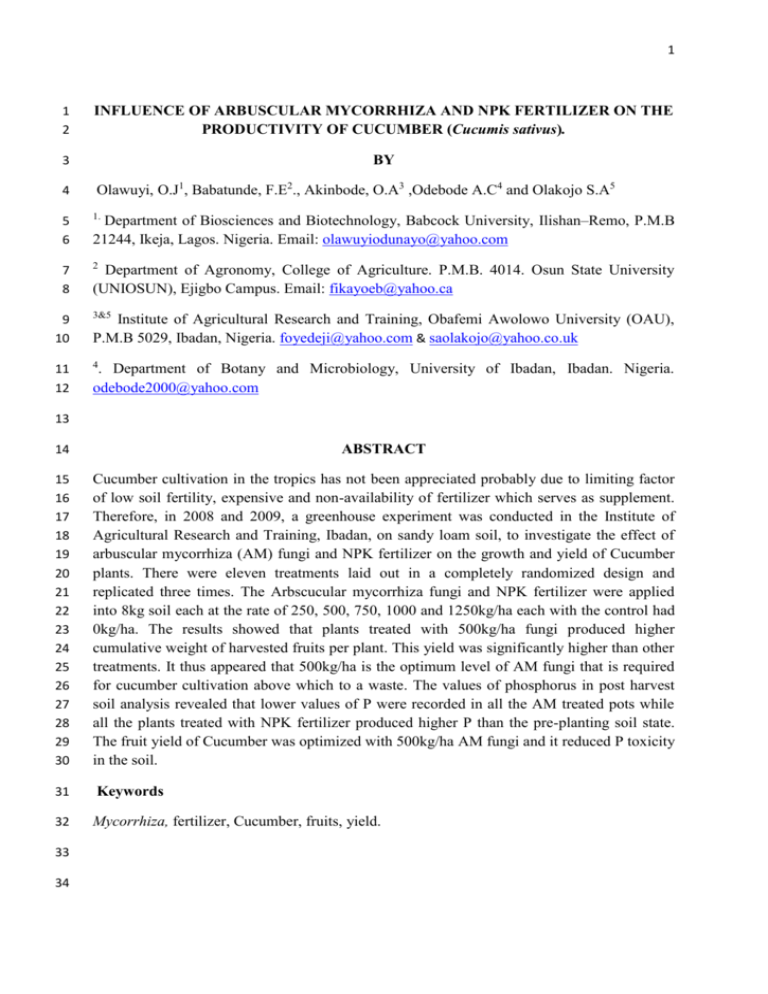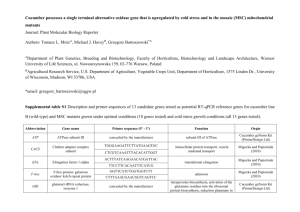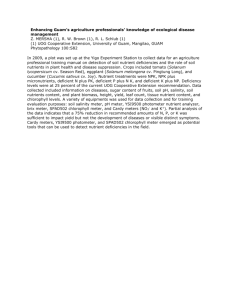Effect of Arbuscular mycorrhiza and NPK compound fertilizer on the
advertisement

1
1
2
INFLUENCE OF ARBUSCULAR MYCORRHIZA AND NPK FERTILIZER ON THE
PRODUCTIVITY OF CUCUMBER (Cucumis sativus).
3
BY
4
Olawuyi, O.J1, Babatunde, F.E2., Akinbode, O.A3 ,Odebode A.C4 and Olakojo S.A5
5
6
1.
7
8
2
Department of Biosciences and Biotechnology, Babcock University, Ilishan–Remo, P.M.B
21244, Ikeja, Lagos. Nigeria. Email: olawuyiodunayo@yahoo.com
Department of Agronomy, College of Agriculture. P.M.B. 4014. Osun State University
(UNIOSUN), Ejigbo Campus. Email: fikayoeb@yahoo.ca
9
10
3&5
11
12
4
Institute of Agricultural Research and Training, Obafemi Awolowo University (OAU),
P.M.B 5029, Ibadan, Nigeria. foyedeji@yahoo.com & saolakojo@yahoo.co.uk
. Department of Botany and Microbiology, University of Ibadan, Ibadan. Nigeria.
odebode2000@yahoo.com
13
14
ABSTRACT
15
16
17
18
19
20
21
22
23
24
25
26
27
28
29
30
Cucumber cultivation in the tropics has not been appreciated probably due to limiting factor
of low soil fertility, expensive and non-availability of fertilizer which serves as supplement.
Therefore, in 2008 and 2009, a greenhouse experiment was conducted in the Institute of
Agricultural Research and Training, Ibadan, on sandy loam soil, to investigate the effect of
arbuscular mycorrhiza (AM) fungi and NPK fertilizer on the growth and yield of Cucumber
plants. There were eleven treatments laid out in a completely randomized design and
replicated three times. The Arbscucular mycorrhiza fungi and NPK fertilizer were applied
into 8kg soil each at the rate of 250, 500, 750, 1000 and 1250kg/ha each with the control had
0kg/ha. The results showed that plants treated with 500kg/ha fungi produced higher
cumulative weight of harvested fruits per plant. This yield was significantly higher than other
treatments. It thus appeared that 500kg/ha is the optimum level of AM fungi that is required
for cucumber cultivation above which to a waste. The values of phosphorus in post harvest
soil analysis revealed that lower values of P were recorded in all the AM treated pots while
all the plants treated with NPK fertilizer produced higher P than the pre-planting soil state.
The fruit yield of Cucumber was optimized with 500kg/ha AM fungi and it reduced P toxicity
in the soil.
31
Keywords
32
Mycorrhiza, fertilizer, Cucumber, fruits, yield.
33
34
2
35
INTRODUCTION
36
37
38
39
Cucumber, Cucumis sativus L. is an important fruit vegetable with great economic potentials,
as medicinal plant and source of industrial raw materials. Cucumber is a dependable laxative
food for those who suffer constipation. The juice of cucumber is a valuable medicinal food in
the treatment of hyperacidity gastric and duodenal ulcers (Ernestina, 2001).
40
41
42
43
44
45
46
47
48
49
50
51
52
53
54
55
56
In Nigeria, Cucumber production and utilization have not been a viable option to farmers
despite the numerous benefits and economic importance of this crop. This might be in part
due to the declining soil fertility, which prevents optimum yield and the short shelf life of
Cucumber fruits which leads to early deterioration. An understanding of crop nutrient
requirement and the use of best fertilizer are important keys to growing healthy and profitable
cucumber crop. Cucumbers do not perform well in acid soil but do well under slight acidity
The optimum pH is 5.5 – 7.0 (Donald, 1980). Valenzuela et al., (2005) recommended that if
the soil pH is below 5.8 and available calcium is less than 95kg/acre, 95/acre of agricultural
lime must be applied at 8-12 weeks before planting. Great fluctuation in any of the growing
condition will result in less fruit being produced and bitter tasting cucumber (Huxdy, 1992).
Although chemical fertilizer promotes healthy, robust plant growth and give high yield there
is a point at which it become toxic and retard plant growth and fruit production. Hence, to
prevent the toxicity of soil caused by fertilizers and to overcome droopy of the plant, a
characteristic symptom of overuse of fertilizer, alternatives to the use of inorganic fertilizers
should be developed. This alternative should be environmentally friendly, readily available
and cheap for a common farmer. These reasons have brought to mind the use of Arbuscular
mycorrhiza, AM fungi.
57
58
59
60
61
62
63
64
65
66
67
68
69
AM fungi are particularly important in improving uptake of Phosphorous because of the very
short transmission distance of phosphate ions in the soil. They also enhance the uptake of
secondary and micro-nutrients including calcium, sulphur, zinc and copper (Blat et al., 1990).
George et al, (1992) asserted that most agricultural crops can perform better and are more
productive when they are well colonized by AM Fungi inoculation of plant roots with AM.
Fungi has also been reported to enhance phytoaccumulation of heavy metals such as zinc,
cadmium, arsenic and selenium (Khan et al., 2000; Al-agely et al., 2005). To overcome these
deficiencies in cucumber cultivation, the use of Arbuscular mycorrhizae and NPK compound
fertilizer was tested on the crop. Since it was reported that AM plants receiving 50% of
recommended rate exhibited comparable or better growth, higher N, P and K and
marketability than non-AM plants at 100% fertilizer rate (Carpio et al., 2005) Therefore, the
objective of this study was to evaluate the effect of the Arbuscular mycorrhizae fungi and
NPK compound fertilizer on the growth and yield of Cucumber.
70
MATERIALS AND METHOD
71
72
73
74
The experiment was conducted for two years (2008 and 2009) in the greenhouse of Institute
of Agricultural Research and Training (IAR&T), Ibadan, Nigeria. Top-soil (0 – 30cm depth)
was collected randomly at the research farm of the institute. The soil was air-dried and sieved
using 2mm sieve. Sample of the soil was analysed for physical and chemical parameters. The
3
75
76
77
78
79
80
81
82
83
84
85
experimental design used was Completely Randomized Design (CRD) with 3 replicates. The
AM fungus and NPK fertilizer each was used at 250, 500, 750, 1000 and 1250kg/ha while the
control was not treated. The AM fungus used for the study was Glomus deserticola. The soil
used was hot air sterilized at 270o C, was filled into plastic pots at 8kg which were arranged at
50 x 50cm spacing distance in the greenhouse. Three seeds of ‘Palomar’ variety of Cucumber
obtained from National Institute of Horticultural Research and Training (NIHORT) were
planted per pot and later thinned to two seedlings. Both NPK15-15-15 and G.deserticola
were randomly applied into the pots immediately after planting according to the treatments
with the exception of the control pots that were not treated with either fertilizer or
G.deserticola. All agronomic practices were duly carried out. Watering was carried out at
twice a week to prevent water logging.
86
87
88
89
90
91
92
93
Data collected at 2, 4, 6, 8 weeks after planting on growth parameters were vine length (cm),
number of leaves per plant as well as number of branches per plant. Nine successive
harvesting were carried out at weekly interval and yield parameters were taken at each
harvest. These include number of harvested fruits per plant, weight of harvested fruits per
plant and weight of harvested fruits per pot. Also, soil samples were taken for post harvest
analysis to ascertain its nutrients contents. All the data were subjected to statistical analysis of
variance (ANOVA) with the use of SAS version 5 statistical software, while the means were
separated with Duncan Multiple Range Test (DMRT).
94
RESULTS AND DISCUSSION
95
Physical and chemical properties of pre-planting soil analysis
96
97
98
99
100
101
102
103
104
105
The physical analysis of the soil used for this experiment revealed that it contained 88.4%
sand, 8.4% clay and 3.2 % silt acid was sandy loam in texture. The soil pH was slightly acidic
with pH value of 6.53. The available phosphorous level in the soil was 3.53mg/kg which is
suitable for growing of cucumber according to Valenzuela et al., 2005. Ca content of the soil
was significantly higher than 250kg/ha NPK treatment when 250kg/ha AM was applied and
was not significantly different compared with the control. AM showed the tendency of
reducing the pH level of the soil. P uptake by AM at all levels for plant use was significantly
lower to NPK application. Na and Mg left in the soil were not significantly different from the
control and before planting. The use of 250kg/ha AM was significantly different from other
treatments but similar to 500kg/ha AM. Table 5 shows result of N, K Ca and Mg.
106
Growth and Yield parameters
107
108
109
110
111
112
113
There was no significant difference in the number of leaves produced per plant among the
plants treated with different rates of Arbuscular mycorrhiza at 2,4,6,8 weeks after planting.
However, plant treated with 1250kg/ha AM produced highest number of leaves (5,12 and 17)
leaves per plant at 4, 6 and 8 weeks after planting respectively compared with other AM
treatments (Table 1). The treatment also produced significantly higher number of leaves than
the control plant at 8WAP (Table 2). Plants grown with NPK 15-15-15 fertilizer were not
significantly different from each other with respect to the number of leaves per plant at 4, 6
4
114
115
116
117
118
119
120
and 8WAP. Irrespective of the dosage, plants treated with 250kg/ha of N.P.K had highest
values at 4th and 6th week after planting (6 and 13 respectively). Both the NPK and AM
treatments were not significant from each other with exception of the lowest rate of AM at
250kg/ha that recorded significantly lowest mean number of leaves than plant treated with
250kg/ha of N.P.K. fertilizer at 4th and 6th WAP. This confirms the work of Schippers, 2000
which reported that application of nitrogen is particularly useful in promoting the vegetative
portion of the plant, producing large green leaves, and also necessary for dropping of fruits.
121
122
123
124
125
The vine length of plants treated with AM (irrespective of the rates) were not significant
(P<0.05) from those that received higher doses of NPK fertilizer (750, 1000 and 1250kg/ha)
at 2, 4, 6 and 8 WAP. Though, plants treated with the lowest rate of NPK (250kg/ha)
recorded the longest vine length at 2, 4, 6 and 8 WAP but not significantly different from
those plant that received 500kg/ha of NPK (Table 2).
126
127
128
129
The leaf area of plants treated with 250 and 500kg/ha of N.P.K were not significant (P<0.05)
at 2, 4, 6 and 8 WAP while the highest rate of N.P.K (1250kg/ha) produced the largest leaf
area at 8 WAP. However, these were not significantly different from plants treated with
500,750, 1000, 1250kg/ha AM and even the control.
130
131
132
133
134
Irrespective of the rates used, plant grown with N.P.K produced non-significant mean number
of branches per plant at 2, 4 and 8 WAP. Likewise, it was so far the plants treated with AM at
2, 4, 6 and 8 WAP. Plants treated with higher rates of NPK (750, 1000, 1250) kg/ha produced
non-significant number of branches per plant compared with plants treated with AM
(irrespective of rates) (Table 3).
135
136
137
138
139
140
141
142
Mean number of fruits produced per plant on cucumber grown with 500kg/ha of AM was
found to be the highest among all the treatments. The value (5.00) was not significantly
different from those recorded from plant treated with 750kg and 1000kg/ha of AM, and
plants treated with 500kg and 1250kg/ha of NPK fertilizer but significantly different from
other treatments and the control (Table 4). This confirmed the work of Bamidele (2000) that
an increase in the yield of cucumber as the NPK rate increases from 200 to 400kg/ha. This
however disagreed with the findings of Glumtsov et al., (1975) who reported a depression in
cucumber yield as the NPK rate increased.
143
144
145
146
147
148
With respect to the weight of harvested fresh fruit of Cucumber per plant, those that were
treated with 500kg/ha of AM produced significantly highest yield per plant compared with
the other treatments in this experiment, (590.65g plant) (Table 4). Akinsanmi (1995) revealed
that phosphorous is essential for flowering and fruits formation. However, large quantities of
phosphorous sometimes may be present in the soil but not available to the growing plant
because it may be insoluble in such situation.
149
150
151
5
152
Post harvest soil analysis on Ca, Mg, Na, K, P and pH.
153
154
155
The value of calcium content on the post harvest soil treated with 250kg/ha AM recorded
highest significant value compared with 1000kg/ha AM and 1000kg/ha N.P.K but not with
the other treatments’ values.
156
157
158
159
160
161
Magnesium (Mg) value from applying 250kg/ha AM was highest and significantly different
from all other treatments. Sodium (Na) value was significantly lower (0.14) in 1000kg/ha
AM applied soil than other treatments. The potassium (K) value was significantly higher in
500kg/ha AM (1.63) than 250kg/ha NPK but not with others. Phosphorous was significantly
higher in 1000kg/ha NPK soils (15.63) than other treatments except 750kg/ha NPK and the
control pots.
162
163
164
165
166
167
168
169
170
Lower values of P were observed in all the AM treated soil relative to the N.P.K treatment
and significantly higher than the value in control soil as well as soil treated with higher rate
of NPK fertilizer (Table 5). This proved the ability of AM to encourage absorption/uptake of
P in the soil as earlier reported by Smith and Read (1997) which stated that AM are very
effective in helping the plants to absorb P from the soil and invariably prevents P runoff that
leads to eutrophication(undesired biological growth and productivity) because agriculture is a
source of phosphate pollution in the environment, increased phosphorous uptake by
mycorrhiza plants can help to reduce the quantity of this nutrient to be added to the soil, and
decrease the accumulated phosphorous soil and water.
171
172
173
174
175
NPK compound fertilizer also increased phosphorous level in the post harvest soils and might
cause phosphorous pollution in the environment because P is an immobile nutrient and it is
susceptible to fixation by certain chemical agent such as aluminium and iron (Akinsanmi,
1996). Sometimes large quantities of phosphorous may be present in the soil but not available
to the growing plants because it is insoluble in such situation.
176
CONCLUSION
177
178
179
180
181
The results showed that plant treated with 500kg/ha AM fungus produced higher cumulative
weight of harvested fruits (590.65g/plant) which was significantly different from other
treatments. Also, among the treatments with NPK compound fertilizer the highest cumulative
yield 364.6g/plant was obtained from plant treated with 500kg/ha NPK which was
significantly different from other treatments.
182
183
184
185
186
The use of 500kg/ha AM fungus can be recommended for farmers since most agricultural
crops can perform better and more productive when well colonized by AM fungus, especially
in the cultivation of Cucumber. The farmers should be encouraged to the use AMF as it is
environmentally friendly, required no specialized skill for it application and there is no need
of frequent application as it is in the case of NPK compound fertilizer.
187
188
6
189
REFERENCES
190
191
Al-agely, A.K, Scagel, C.F., Chellemi D.O (2005). Phytoaccumulation of metals at the
Sunny.www.instytucja.pan.pl/ images/stories/pliki/pnr.
192
193
194
Amerian, M.R, and Stewart, W.S (2001) Effect of two species of arbuscular mycorrhizal
fungi on growth, assimilation and leaf water relations in maize( Zea mays).
Aspects of Applied Biology 63:1-6.
195
196
Akinsanmi, O. (1995, 1996). Certificate Agricultural Science. Oxford University Press.
Revised Edition.
197
198
199
Bamidele, A.L. (2000). Response of cucumber to intercropping with maize and varying rates
of inorganic fertilizer and farmyard manure, unpublished thesis Ahmadu
Bello Univ., Zaria. 140pp
200
201
Blat, A. Sylvia, D.M.; Chrispeels, M.J (1990). Proteins for transport of water and mineral
nutrients.www.scielo.cl/scielo.php.
202
203
204
205
206
Carpio, L.A., Davies, Jr., Arnold, A.A (2005). Arbuscular mycorrhiza fungi, organic and
inorganic controlled – released fertilizers. Effect on growth and leachate of
container – grown Bush morning Glory (Ipomoeba Carnea subsp.
Fistulosa) under high production temperatures. Journal of American
Society for Horticultural Sciences 130(1) : 131-139.
207
Ernestina, P. (2001). Cucumber. http.www.earthnotestripod.com/cucumber.html
208
209
Donald, J. (1980). Seed company modern cucumber technology evan brothers Ltd Kenya,
Nairobi. Pp 54-56.
210
Gemma, A.; Hohnjec, N.; Vieweg, M.F., Puhler, A.; Becker, A., Kuoter, H.(1997).
211
Overlaps in transcriptional profile of M. truncatula root activated
212
using arbuscular mycorrhiza. Plant physiol.137:1283-1301.
213
214
Huxley C.R (1992). Sustainable use of biological diversity in socio-ecological.
www.cbd.int/doc/ publications/cbd-ts-52-en.pdf.
215
216
217
George, E.K., Haussler, S.K. Kothari, X.L., and Marshner (1992). Contribution
of
mycorrhiza hyphae to nutrient and water uptake of plants. In mycorrhizas in
Ecosystems. Pp 42-47.
218
219
220
Glumstov, N.M., Dmitrieva, L. V., Kuts, M.G and Baukora, N.S (1975). The effect of
fertilizers on yield of cucumbers grown on straw bales. Reforativinyl
Zhurnal. No.3:54 -57.
221
Khan A.G, Kuek, T.M, Chaudhry, A (2000).linkinghub.elsevier.com/retrieve/psii/.
7
222
McGonigle T. P., Millner P.D, Mulbry W.W, Reynold S.L (2001) Taxon specific
223
oligonucleotide primers for detection of Glomus etunicatum.
224
Mycorrihiza
10:259 – 265.
225
226
Schippers, R.R (2000). African indigenous vegetable. An overview of the cultivated species.
National Resources Institute, walking ford oxio 8DE UK.
227
Schwarzott, D and Schubler, A. (2001). A simple reliable method SSU rRNA gene DNA
228
extraction, amplification and cloning from single AM fungi spore.
229
Mycorrhiza 10:203- 207.
230
231
232
Smith, S.E and D.J. Read (1997). Vesicular Arbuscular mycorrhiza in agriculture and
horticulture. In: mycorrhiza symbiosis. Second edition Smith, S.E and D.J.
Read (eds), Academic Press, London, UK. Pp 453-69.
233
234
235
Valenzuela, H., Hamasaki, R.T. and Fukuda, S. (2005). Field cucumber production guidelines
for
waii.
http/www.Extentohawii.edu/kbase/reports/cucumber
production.html.
236
237
238
239
240
241
242
Table 1. Effects of AMF and NPK compound fertilizer on the number of leaves of Cucumber
(mean of two years).
Treatment
2WAP
4WAP
6WAP
8WAP
Control
3.00ab
4.67ab
9.00ab
7.33b
250kg/ha NPK
3.33ab
6.33a
13.00a
10.33ab
500kg/ha NPk
3.67a
5.67ab
12.67a
12.33ab
750kg/ha NPK
2.00b
4.33ab
7.67ab
10.00ab
1000kg/ha NPK
2.67ab
3.67ab
8.67ab
6.67ab
1250kg/ha NPK
2.33ab
4.33ab
10.00ab
14.67ab
250kg/ha AM
2.67ab
4.00ab
8.00ab
8.67ab
500kg/ha AM
2.00b
3.00b
6.33b
9.67ab
750kg/ha AM
2.33ab
4.00ab
7.00ab
13.67ab
1000kg/ha AM
3.00ab
4.67ab
8.33ab
8.33ab
1250kg/ha AM
2.00b
5.00ab
12.00ab
17.00a
Means with the same column are not significantly different from each other (P<0.05).
8
243
244
Table 2: Effect of AMF and NPK compound fertilizer on the vine length (cm) of Cucumber
(mean of two years).
245
Treatment
2WAP
4WAP
6WAP
8WAP
Control
13.67ab
30.67c
85.00c
93.00ab
250kg/ha NPK
26.00a
67.00a
167.00a
181.00a
500kg/ha NPk
19.33ab
60.33ab
145.67ab
179.00a
750kg/ha NPK
14.33ab
35.67bc
89.33bc
109.33ab
1000kg/ha NPK
14.67ab
44.33abc
97.67bc
110.33ab
1250kg/ha NPK
9.67b
40.00bc
113.00abc
166.00ab
250kg/ha AM
13.00b
21.33c
69.33c
81.00b
500kg/ha AM
11.67b
18.33c
62.33c
110.33ab
750kg/ha AM
14.00ab
29.33c
69.33c
127.67ab
1000kg/ha AM
14.00ab
30.67c
75.33c
79.33b
1250kg/ha AM
13.00b
39.67bc
83.67c
121.67ab
Means with the same column are not significantly different from each other (P<0.05).
246
247
248
249
250
251
252
253
254
255
256
Table 3. Effects of AMF and NPK compound fertilizer on the number of branches of
Cucumber (mean of two years).
Treatment
2WAP
4WAP
6WAP
8WAP
Control
1.67ab
3.67ab
11.33b
14l.33
250kg/ha NPK
3.67a
6.33a
21.67a
17.67
500kg/ha NPk
3.67a
6.33a
16.67ab
17.00
750kg/ha NPK
2.00ab
4.00ab
10.00b
11.67
1000kg/ha NPK
1.67ab
4.67ab
14.67ab
11.00
1250kg/ha NPK
2.00ab
3.67b
17.33ab
19.67
250kg/ha AM
1.30b
2.67b
9.67b
12.00
500kg/ha AM
1.00b
2.33b
7.67b
12.67
750kg/ha AM
1.67ab
3.67ab
10.00b
13.00
1000kg/ha AM
2.00ab
3.67ab
13.33ab
19.00
1250kg/ha AM
2.33ab
5.67ab
15.67ab
16.00ns
Means with the same letters in the column are not significantly different from each other
(P<0.05).
9
257
258
Table 4. Effects of AMF and NPK fertilizer on cumulative fruit yield of Cucumber (mean of
two years).
Treatment
259
260
Control
250kg/ha NPK
500kg/ha NPk
750kg/ha NPK
1000kg/ha NPK
1250kg/ha NPK
250kg/ha AM
500kg/ha AM
750kg/ha AM
1000kg/ha AM
1250kg/ha AM
Means with the
(P<0.05).
number of fruit
weight of fruit
Per plant
per plant (g)
1.00d
131.35cd
2.67c
57.88cd
3.67abc
364.57b
1.00d
50.34d
3.33bc
182.42cd
3.67abc
215.10c
1.33d
165.18cd
5.00a
590.65a
4.33ab
377.80b
3.67abc
446.10b
2.67ab
406.94b
same letters in the column are not significantly different from each other
261
262
263
Table 5: The result of pre and post planting soil analysis on Ca, Mg, Na, K, P, and pH (mean
of two years).
Treatment
Pre-planting
Control
250kg/ha NPK
500kg/ha NPK
750kg/ha NPK
1000kg/ha NPK
1250kg/ha NPK
250kg/ha AM
500kg/ha AM
750kg/ha AM
1000kg/ha AM
1250kg/ha AM
264
265
Ca
2.68ab
3.01ab
2.93ab
2.62a
2.89ab
2.41b
3.00ab
3.57a
2.76ab
2.79ab
2.28b
3.05ab
Mg
0.27b
0.36b
0.30b
0.29b
0.31b
0.29b
0.29b
0.53a
0.33b
0.33b
0.29b
0.32b
Na
0.23a
0.19ab
0.26a
0.20ab
0.25a
0.23a
0.24a
0.26a
0.25a
0.20ab
0.14b
0.24a
K
1.19ab
0.34ab
0.22b
0.35ab
0.61ab
0.84ab
0.34ab
0.34ab
1.63a
0.34ab
0.34ab
0.36ab
P
3.53c
12.09ab
5.02c
5.61c
11.76ab
15.63a
9.74b
2.25c
3.18c
2.72c
1.96c
4.23c
pH
6.53b
7.37ab
6.77c
7.23ab
6.87ab
7.70a
6.77ab
7.07ab
7.13ab
7.13ab
7.53ab
7.13ab
Means with the same letter in the same column are not significantly different {P<0.05}








